In 1935 John Wayne made the first of eight appearances as Stony Brooke in the ongoing Three Mesquiteers five-reelers for Republic Studios. Wayne took over the role from Bob Livingston who played the character in all but one of the previous sixteen entries in the series.
All of the films in which JW played Stoney were directed by George Sherman, who also directed the late career classic Western for the actor, “Big Jake”, over 30 years later.
Along for the ride is Ray Corrigan as Tucson Smith and Max Terhune as Lullaby Roslin. There’s also an intermittent appearance by another character, but we’ll get to that later.
“Pals of the Saddle” was the first of these eight films JW appeared in, hitting paydirt in “Stagecoach” halfway through his run as Stony, and completing the last four in the wake of his newfound stardom as the Ringo Kid.
This article includes affiliate links. If you choose to purchase any of the products we have discussed in this article, we may receive a small commission but it won’t affect what you pay.
Having already reviewed the films in an earlier article I thought this time around I’d re-evaluate Wayne’s Mesquiteer movies and rate them in order of preference. Hope you agree with me.
You can get on DVD the Three Mesquiteers: Ultimate Collection – Volume 1
The John Wayne Three Mesquiteers Movies – Positions Eight to Five
8. Three Texas Steers (1939)
I have to say how confused I was to discover that a number of the Mesquiteer films took place in a weird mashed up world of cowboys and modern day surroundings, and this, the sixth entry in the series, is one of the weirdest of them all.
It’s basically a circus drama set in what looks like the 1930s and features a gramophone playing a vinyl recording of The Blue Danube, a telephone and a motorised jeep with caterpillar tracks that is used to haul a racing horse to the local track heavily populated by racegoers dressed in 20th century business suits. Someone even refers to a jitterbug contest so, in the end, I decided to just give up and go with the flow – it was easier that way.
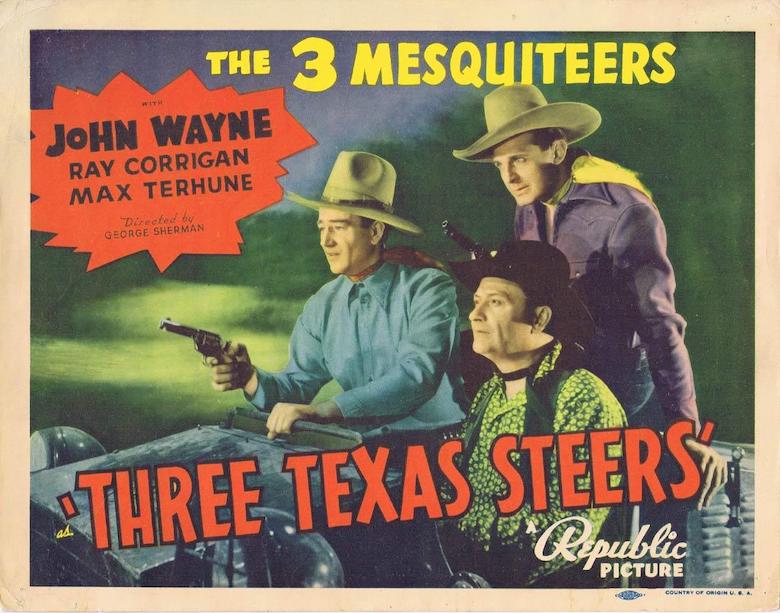
The basic story involves a crooked circus manager who contrives to close a traveling circus run by his boss, Nancy, who also owns a ranch that’s worth a lot of money, and the business manager intends to get his hands on that ranch through devious means.
When the circus goes bust – cue a fairly impressive montage sequence worthy of Eisenstein when the big tent catches fire – the now unemployed Nancy returns to her ranch but mistakenly goes to the home of The Three Mesquiteers, who own the 3 – M ranch. Her place is called the W – E ranch but the sign is upside down and she mistakes the W – E ranch for the 3 – M ranch, resulting in the Mesquiteers nearly losing their ranch.
Along the way, the audience is introduced to a wooden dummy by the name of Elmer.
The strange thing is that the dummy actually moves even though there’s no one to operate him. I always thought those things required an arm to be shoved up where the sun don’t shine in order to animate them. Obviously not.
And we get to understand why he’s called Lullabye. He sings his dummy to sleep. I swear the only thing missing is FBI agent Dale Cooper sitting round a campfire and declaring he’s just drunk a ‘damned fine cup of coffee’.
What with Wayne and the boys losing the mortgage on the ranch and then in quick succession losing the money they got for the mortgage, then finding a letter proving the circus business manager is corrupt before then losing the letter as well, I’d be inclined to redub them as The Three Stooges instead.
My initial review stated that the only thing going for these films is that they’re quite short. Checking “Three Texas Steers” out again I still stand by that first impression.
7. Pals of the Saddle (1938)
“Pals of the Saddle” is the first of the JW Stony Brooke films and begins with a montage of modern battle images that appears to be representing WWI but then introduces a newspaper headline declaring that “Congress Passes Neutrality Act”. America actually passed four Neutrality Acts between 1935 to 1939, placing the story somewhere in between those years.
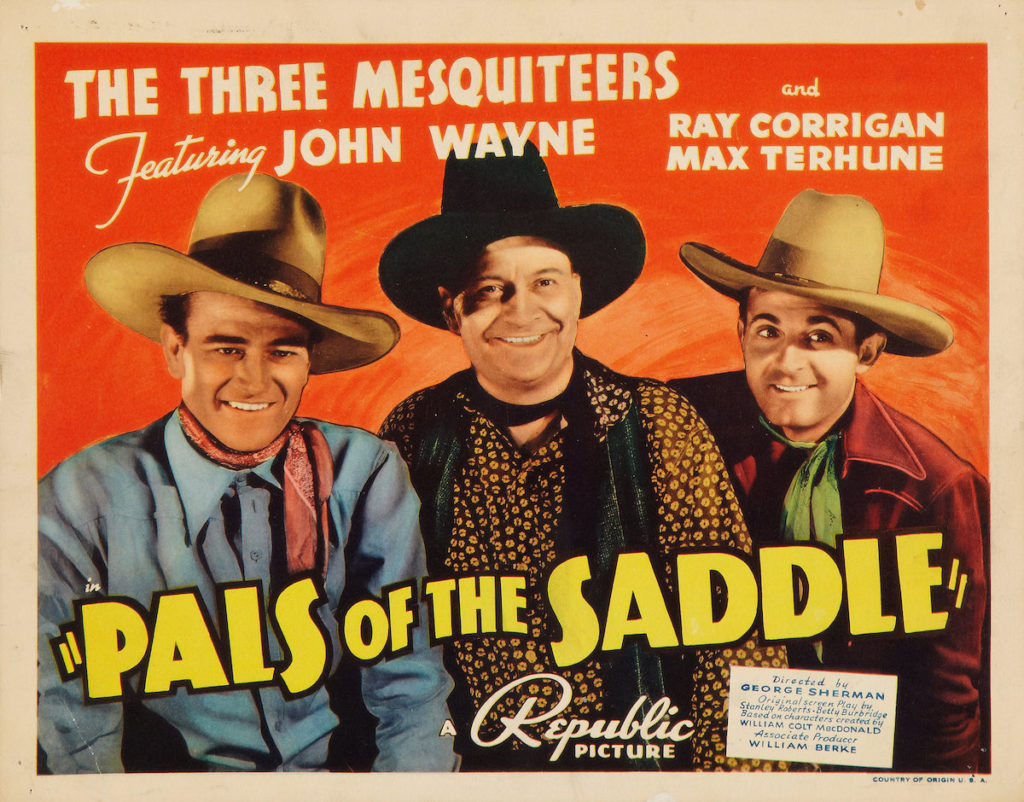
The plot revolves around a poison gas called Monium, on which an export embargo is placed by the authorities.
It’s already beginning to sound like one of those complicated trade federation subplots from the lamentable Star Wars prequels, and we’re barely two minutes into the film.
Eventually, our heroic trio appears, Stony in the middle astride his magnificent white horse, with his faithful companion Tucson Smith to the left of him, whilst to the right, we see comedy relief Lullaby Joslin holding what looks like a dead kid in his arms.
It’s not of course; it’s actually Elmer the dummy, which is a bit of a relief seeing as I was prepared to abandon the review right here.
Meanwhile, a sneaky looking feller by the name of Paul, played by George Douglas, goes riding in the country with the lovely Ann, played by Doreen McKay.
After a little spat, Ann’s horse bolts and she is rescued by white knight Stony, who is rather perplexed when Ann doesn’t appear to be too grateful for being rescued in the first place. Lucky it wasn’t Elmer who took off after her. She’d be dead by now.
It turns out that Paul is a foreign agent who has been tasked with smuggling the deadly poison Monium out of the country and Ann is also an agent working undercover to help root out whatever dastardly business lover boy is involved in.
After this, it starts getting a bit complicated. In fact, considering the main premise of the film revolves around a chemical weapon that could possibly kill millions of people it’s all rather farcical if truth be told, but when you’re watching a guy operating a dummy that he converses with while there’s no one else around then any attempt at seriousness kind of goes straight out the window.
Stony, for reasons too complicated to go into here, finds the mysterious Ann in a cabin tending her wounded fellow agent who also, as she mentioned earlier on in order to throw people off the trail, happens to be her intended.
Either way, it’s a short engagement as the poor guy expires, but not before spilling the beans on the who, what and why of how the Monium is going to be smuggled out of the country.
What with Stony being wanted dead or alive they take the corpse to the local sheriff’s office, JW in disguise as what can only be described as an outlaw hick with an intimidating five o’clock shadow, and convince everyone the dead guy is Stony himself, leaving the real Stony and secret agent Ann free to track down the bad guys.
Stony eventually reunites with the other two Mesquiteers after which a ten-minute wagon chase sequence then ensues, with some fairly spectacular stunts well worth waiting for.
Naturally, the villains are defeated, which they probably deserve after one of them actually says “Get back to your wagons men, and we’ll circle the pass”.
The cavalry comes to the rescue in the nick of time and there’s a little bit of a surprise at the end when Stony doesn’t actually get the girl.
I would have placed this Mesquiteers opus higher up the list but that weird dummy keeps freaking me out.
6. The Night Riders (1939)
“The Night Riders”, the fifth outing for Duke as Stoney Brooke, features Tom Tyler in the cast, settling for a part as a villainous enforcer before taking on JW in “Stagecoach” as killer Luke Plummer.
In this one, a crooked gambler ominously referred to as ‘The Don’ disguises himself as a Spanish landowner and, with the help of a forger, misappropriates a whole passel of land from the rightful owners.
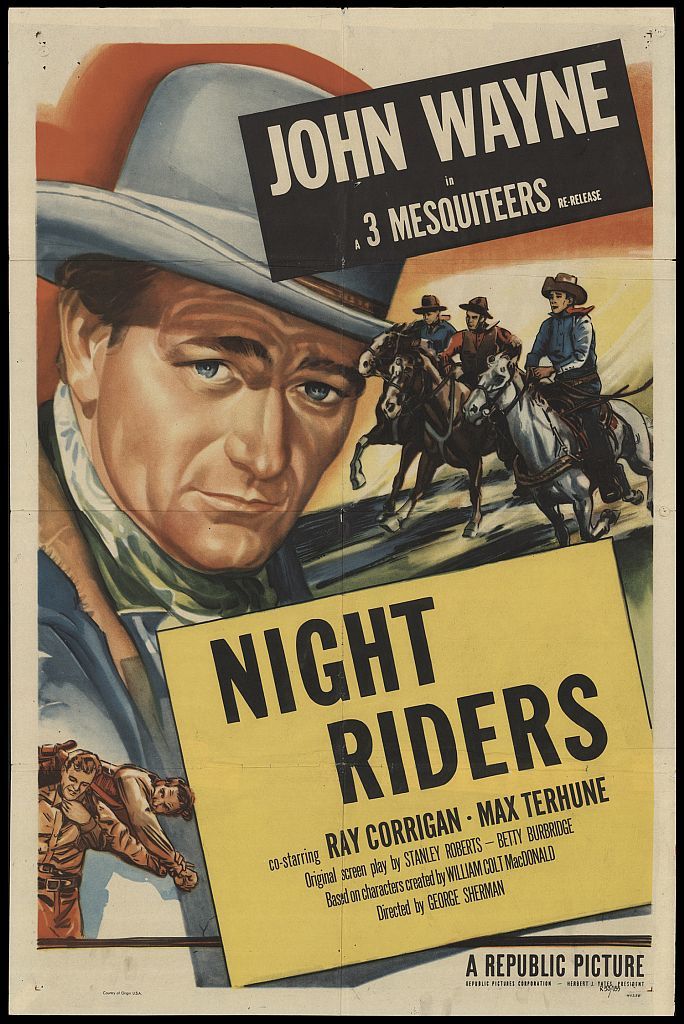
He then imposes a land charge on the homesteaders and therein lies the conflict that brings our heroes into the frame, on account of their ranch is also on the disputed land.
Homesteaders are forced to give up their homes for not paying the tax imposed by the false Spaniard. If you wanted some kind of cultural reference for the film you could argue it invokes the plight of the farmers during the great depression of the 1930s – but I’m not sure you could apply that kind of social conscience subtext to this movie.
At some point in the film The Three Mesquiteers become the Three Masked Merry Men instead, robbing the rich and giving to the poor.
They are dubbed ‘Los Capaqueros’ which as everyone knows is Mexican for ‘those who wear curtains for capes’. It’s all going along quite swimmingly until Elmer arrives on the scene in a sequence which is totally out of synch with the rest of the film.
The story is stretched to further credulity when the Mesquiteers chance upon real-life President Garfield, who gives them the go-ahead to take down the Don, although he can’t be officially involved.
This leaves an informed audience sighing a big ‘uh-oh’ on account of the fact that the real President Garfield was assassinated after less than a year in office. I mean, what are the odds, right?
The climax of the film involves the Mesquiteers being executed by firing squad but we all know that’s not the end as they all come back in the following film.
Apart from President Garfield of course.
One contemporary review noted that exhibitors “have a selling point in John Wayne… based on the approval given his performance in Stagecoach”. Three more Mesquiteer films later and JW was done with the low-budget Republic five-reelers and on his way to stardom.
5. Red River Range (1938)
In the fourth of JWs appearances as Stony Brooke, ‘Red River Range‘, he and the boys find themselves caught up with the Red River Cattlemen’s Association who are gettin’ mighty riled up on account of their beef herds are, according to the ‘Mesquite Sentinel’, “disappearing without a trace”.
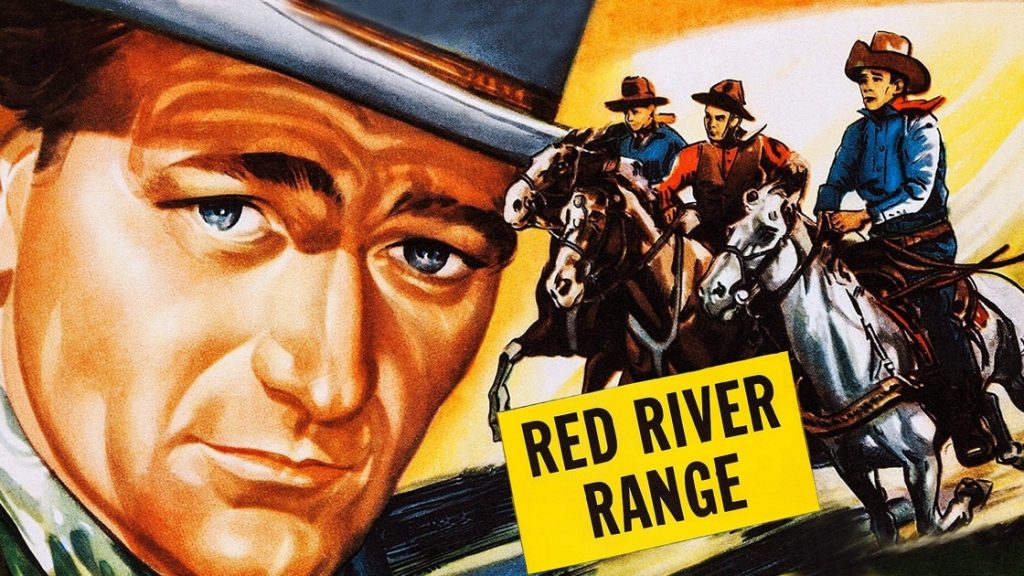
Not only are they disappearing, they’re actually being carted off by a gang of rustlers in a couple of sleek-looking trucks that definitely do not belong anywhere on the prairie in a cowboy movie worth its salt, so we must be back in Time Tunnel land again. Also, it’s stunningly obvious that one of the members of the Association, Hartley, is the villain on account of his pencil-thin moustache which is always a dead giveaway.
Someone comes up with the bright idea of asking the Governor to send help in order to apprehend the rustlers, Hartley of course volunteering to get the ball rolling so he can keep an eye on what the opposition is up to.
Cut to a montage of telegraph machines being clicked, telegraph poles transporting invisible messages of help and a hand retrieving a photograph from a drawer full of Civilian Volunteer Reserves available for undercover missions and what do you know? The Three Mesquiteers get the job.
Their rap sheet says that they’re “top hands, expert gunmen, closed mouthed, dependable and absolutely honest”. No mention that one of them moonlights as a ventriloquist with the weirdest looking dummy I’ve ever seen but I’m betting that’s going to come out in the wash sooner or later.
The Mesqs chance upon their old friend Tex Reilly, played by Kirby Grant, working undercover for the Retail Butchers Association and being chased by the rustlers who don’t want anyone associating themselves with an association of any kind. Things start to get a tad complicated with Stony assuming an alias as Killer Madigan, whilst Tex becomes Stony Brooke in JWs stead.
In the meantime, yet another of those annoying kids that occasionally turn up in these kinds of films, little Tommy Jones, played by Sammy McKim, appears complete with his own working six-shooter which seems to be de rigueur for small children in these later JW 1930s efforts.
His dad gets shot by rustlers, one of them actually trying to shoot Tommy in the back as he rides off for help, which is a bit of an overreaction, to say the least.
Little Tommy recovers remarkably well from the trauma of seeing his father shot to death and quickly accepts Jan’s offer that she and Pop adopt him so no therapy for this kid, although he may grow up to be a serial killer with abandonment issues in his late teens.
Eventually, Stony Brooke aka Killer Madigan finagles an in with the rustlers, helping to round up the bad guys at the end and forcing them into the back of a truck just as they had done earlier did with the cattle, only without the whole abattoir skinning thing.
Strangely enough Stony doesn’t get the girl this time, Jane taking up with and marrying Tex instead. There was some compensation though seeing as, approximately four days after finishing “Red River Range”, he found himself on location for his role as the Ringo Kid in “Stagecoach”. The rest as they say is history.
The film that finally put paid to the career of a one-time movie superstar – and we don’t mean John Wayne.
This article includes affiliate links. If you choose to purchase any of the products we have discussed in this article, we may receive a small commission but it won’t affect what you pay.
You can get on DVD the Three Mesquiteers: Ultimate Collection – Volume 1
The John Wayne Three Mesquiteers Movies – Positions Four to One
Overland Stage Raiders (1938)
This, the second JW Stony Brooke film, is intriguing from the word go seeing as the female lead is played by none other than actress Louise Brooks who, a number of years previously, became an international star with her close-cut stylish bob-cut hair and a leading role as Lulu in the 1929 German movie “Pandora’s Box”.
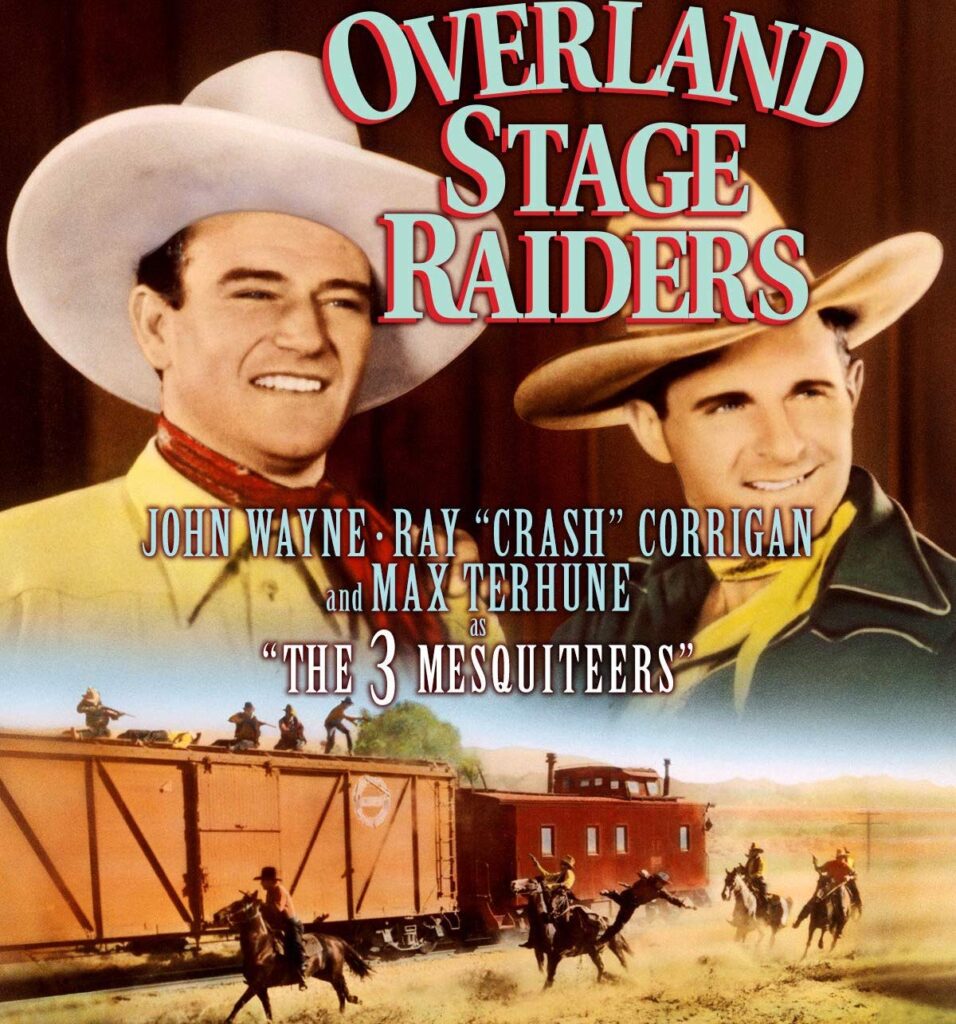
This would prove to be her very last screen appearance.
The beginning of the film comes across like a very early attempt at a Tom Cruise / “Mission Impossible” gig, with Wayne as Stony Brooke parachuting out of a plane in order to stymie a stagecoach holdup, which he manages to accomplish with the aid of the other two Mesquiteers, Tucson and Lullaby.
Seeing as this is one of those modern-day Westerns it shouldn’t come as a surprise when Sandy tells Lullaby to “stay with the bus” instead of “stay with the horses” when he and Tucson ride off after the outlaws. This is because the “stagecoach” actually is a bus, albeit so slow the robbers manage to overtake it on their horses before the Mesquiteers foil their plans.
Stony decides to get into the airplane business, as all cowboys do, and makes an offer to transport gold for the town of Oro Grande by plane as opposed to very slow bus. He does the rounds of the local cattleman, beseeching them to throw money into the hat by selling their cattle in order to raise finance to run the new airline service.
The Mesquiteers buy into an existing service run by Ned Hoyt, played by Anthony Marsh, and his sister Beth, played by the aforementioned Louise Brooks, almost unrecognisable with long black hair.
Into the picture comes Mullins, played by Gordon Hast, owner of the bus company but secretly behind the bus robberies being carried out by the gang of outlaws encountered by the Mesquiteers earlier. In the meantime, to complicate matters, Ned and sis are operating under assumed aliases after Ned was convicted for a crime he didn’t commit.
Hearing that a herd of the cattle have been rustled and loaded on to a train, the Mesquiteers ride to the rescue and retrieve the stolen animals.
During the course of the chase Stony displays a hitherto unknown talent as a train driver by stopping the locomotive after what is actually quite an entertaining chase sequence featuring a couple of impressive horse-riding stunts.
Not to be thwarted, Mullins hires a couple of goons to hijack Ned’s plane after finding out it’s got one-hundred-thousand dollars of gold bullion on board.
The Mesquiteers track down the landed plane, they and the villains blasting away with their guns, the dangers inherent in shooting at an aeroplane that has just been refueled with gallons of oil obviously lost on all concerned, including the scriptwriter.
After the obligatory chase in which Mullins and the gang receive their just deserts Stony, Tucson, Lullaby end up running their very own airline.
All’s well that ends well – apart from Louise Brooks’ movie career.
Santa Fe Stampede (1938)
Be warned – you’ll need to get your handkerchiefs out for this one. The bad guys want someone else’s gold mine so bad they even kill a little girl. Have they no heart?
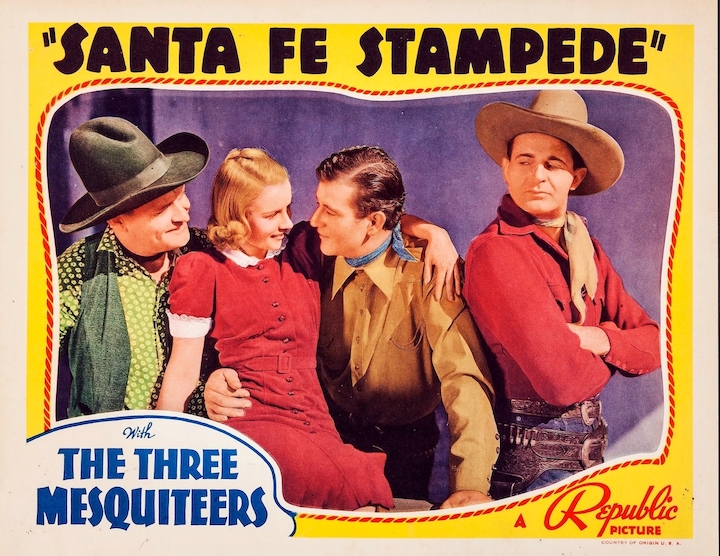
The Mesquiteers grubstake their friend Dave to work a gold mine on their behalf. Stony and the boys find out that Dave hasn’t got around to filing the claim yet on account of the corrupt mayor of Santa Fe Junction, Byron.
Meantime Dave’s trigger happy kids scare off a couple of hombres attempting to steal the Mesqs horses. Our heroes give chase and take one of them, Joe Moffatt, off to jail. The other hombre meets up with Byron and shows him some samples from Dave’s mine which Byron intends to use in order to claim ownership of the mine for himself.
As usual, the town is a nest of corruption with the sheriff and the judge in hock to the mayor. When Stony tries to get Moffatt sent to jail his efforts are side-tracked by
Byron and a false witness. Moffatt goes free and the Mesqs demonstrate their contempt for the lack of justice by trying to beat up everyone within reach. Then Lullaby turns up with the peckerwood dummy Elmer and darn near spoils the whole thing.
Meanwhile, Julie, the little girl with the loaded gun, starts lollygagging and lets on to one of Byron’s gang that she and JW and her daddy are off to lodge a petition of protest with the state governor in order to run the bad guys out of town.
Moffat and another crony kill Dave and his daughter Julie and get the petition back, not realising that Stony has ridden off to file a claim on the mine himself in Dave’s name. The dastardly Byron decides to frame Stony for Dave’s murder, making sure Stony doesn’t live to stand trial.
Stony starts looking more nervous than Joe Burdette whilst he sweats inside the jail house and the town mob grow uglier and uglier but he eventually gets free and confronts the bad guys which ends in the usual fistfight.
On a scale of one to ten, I’d give this a seven, which is why it makes the grade as the third best in the JW Stony Brooke series. It would have been higher but by now I’d had enough of Elmer the dummy.
New Frontier (1939)
“New Frontier (aka “Frontier Horizon”), released August 1939, should not be confused with the earlier 1935 JW / Republic vehicle “The New Frontier”.
It should however be lauded as a milestone in John Wayne’s career as it was the last in the Three Mesquiteers series in which JW played Stony Brooke as well as the last of the five-reelers the actor made for Republic.
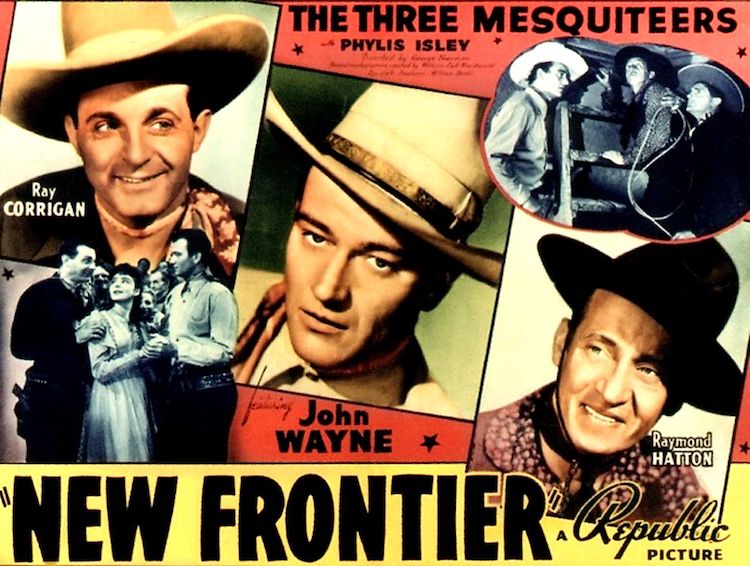
Located in the year 1925, the film concerns the valley of New Hope, threatened by the construction of a new dam that will turn the land into a reservoir. The townsfolk decide to fight back whilst the constructor tasked with building the dam threatens those who oppose it, only to be told by Duke to “take it easy.
You don’t know the kind of people you’re dealin’ with, mister”. You can say that again pardner.
It’s basically another of your “average little guy – or ‘mule-headed hicks’ as they’re referred to – facing off against the tyranny of so-called progress” stories, with that old devil called corruption rearing its ugly head once more.
The suits fool the townsfolk with a phony land deal by promising to build a pipeline that will irrigate their new town if they give up their rights to New Hope.
The climax takes part on what looks very much like a working dam. I’m assuming it was actually a real one as I just can’t see Republic paying for the new construction of a proper dam purely for a Western B-movie that runs for less than an hour.
I kept thinking that I vaguely recognised the actress playing the granddaughter of the town patriarch.
Upon further investigation it turned out to be Jennifer Jones, famous for her portrayal in 1946 of Pearl Chavez, the dusky maiden in “Duel in the Sun” – or “Lust in the Dust” as it was famously dubbed by critics at the time.
Wyoming Outlaw (1939)
Good news, pardners. Someone at Republic Studios saw the light and dropped Lullaby Joslin, the weird one with the wooden dummy, and replaced him with Raymond Hatton as Rusty Joslin.
Not only that but” Wyoming Outlaw” is a far cry from the previous Mesquiteer titles reviewed so far.
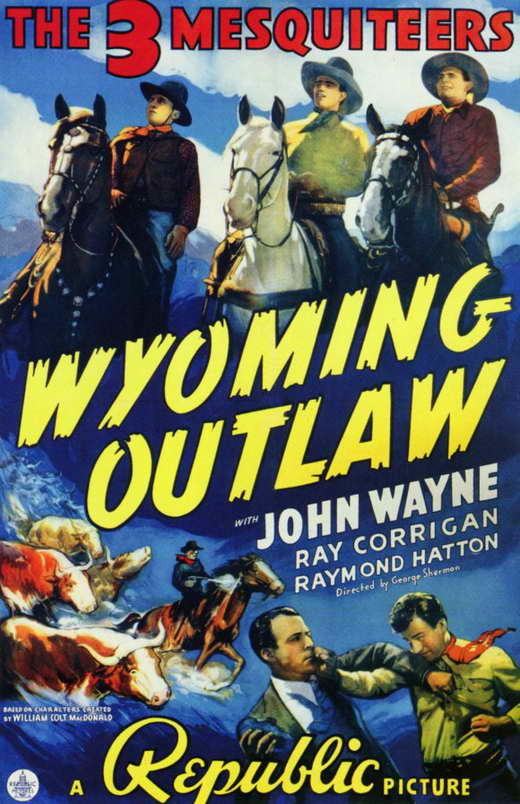
You get the usual punch ups, misguided intentions and hammy acting as before, but this time around the violence is real and people don’t get to dodge the bullets as before.
It’s as though someone with a sense of reality and social commitment has been let loose on the script and the end result is an entertainingly adult B-Western with not one wooden dummy in sight.
This time we’re in 1918 – apparently the Mesquiteers and their fellow cowherders were not aware America had entered the First World War.
Hiding from a huge dust storm, Stoney finds a conveniently placed newspaper that provides a little bit of social history for the audience as regards the reason for the storm.
It seems it’s the result of the land being farmed specifically to provide wheat during the war. Once the war ended the price of wheat fell and most of the farmers were bankrupted, a situation not even the Mesquiteers could sort out.
Chancing upon the daughter of a dirt poor farming family, the Mesquiteers try and help as best they can but her brother, Ray Parker, ends up in trouble with the law when he insists on hunting protected game to feed his family.
Parker, played very convincingly by Don ‘Red’ Barry, points out that ‘the right to eat should come before the right of game to live’. ‘Sounds like pretty good sense’, agrees Stoney. Not a film for animal rights campaigners then.
Once the story starts rolling then the Mesquiteers don’t really feature that much.
They’re depicted more as bystanders in a situation that this time is taken out of their hands as Ray Parker crosses the line into lawlessness and becomes an outlaw on the run.
One aspect of a harder storyline than normal is that people actually start getting killed, something not depicted in the previous episodes. The climax involves Ray sacrificing his own life by taking a corrupt businessman hostage and forcing the law to shoot both of them.
To my mind, this is the best entry in the series, with co-stars such as Elmo Lincoln, the first Tarzan, and Charles Middleton, of Ming the Merciless fame, along for the ride.
Don Barry packs a real punch as the doomed Ray Parker and apart from the tacked on happy ending I’d thoroughly recommend this to anyone who feels like investing their time in checking out Wayne’s lesser known work.
Whilst JWs performances in this second to last Mesquiteer film does not tend to reflect an actor on the cusp of stardom, one does detect a moment in the opening credits when Wayne’s fixed grin starts to falter, as if he’s thinking “for God’s sake get me out of this series before I shoot somebody for real.
I wanna do something like ‘Stagecoach’ again”. Don’t worry, Duke. It all turns out fine in the end.
This article includes affiliate links. If you choose to purchase any of the products we have discussed in this article, we may receive a small commission but it won’t affect what you pay.
You can get on DVD the Three Mesquiteers: Ultimate Collection – Volume 1
Please feel free to add your own opinion as to whether my preferential ratings for JWs Three Mesquiteer films meet your approval – or not as the case might be.

